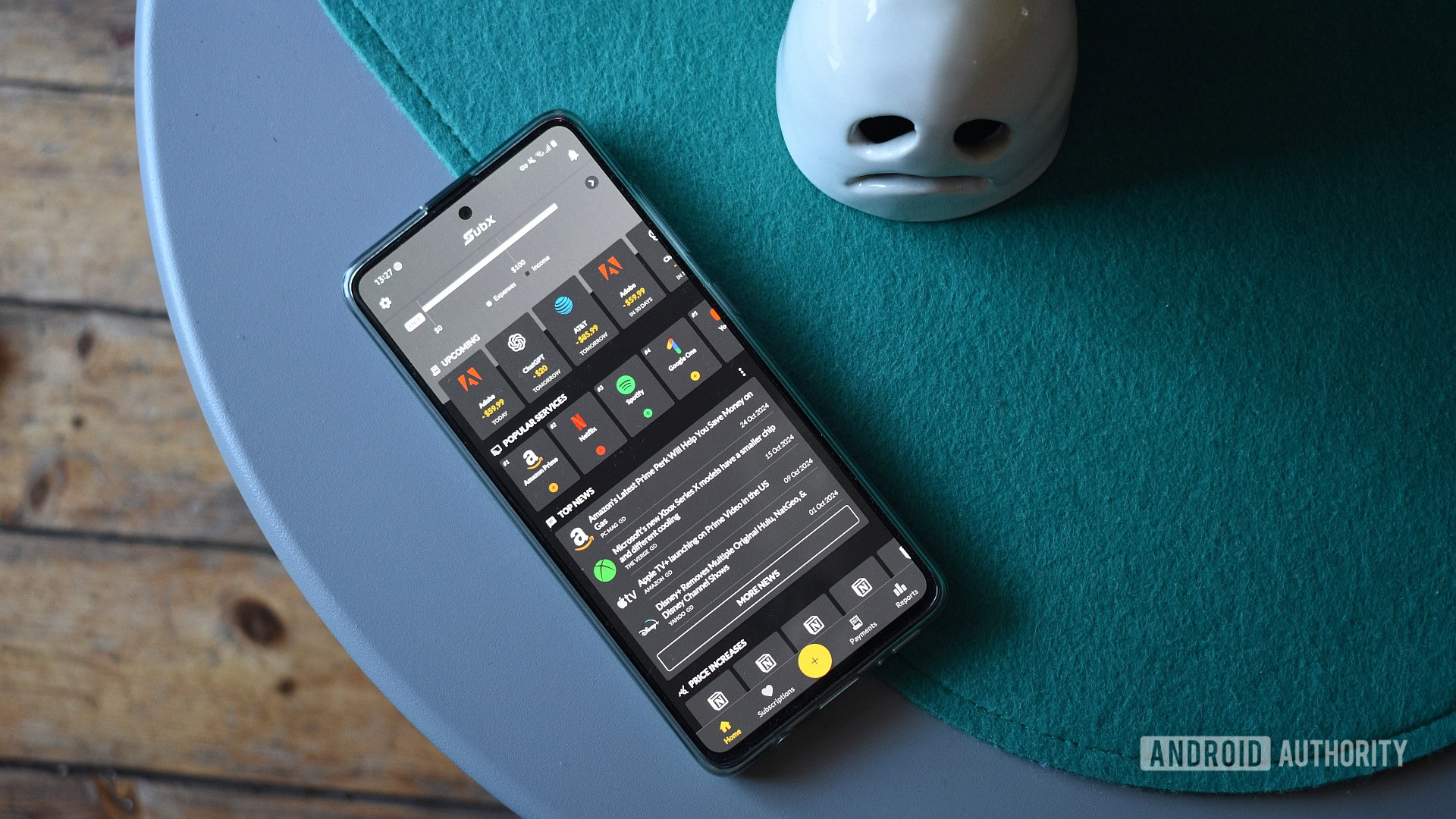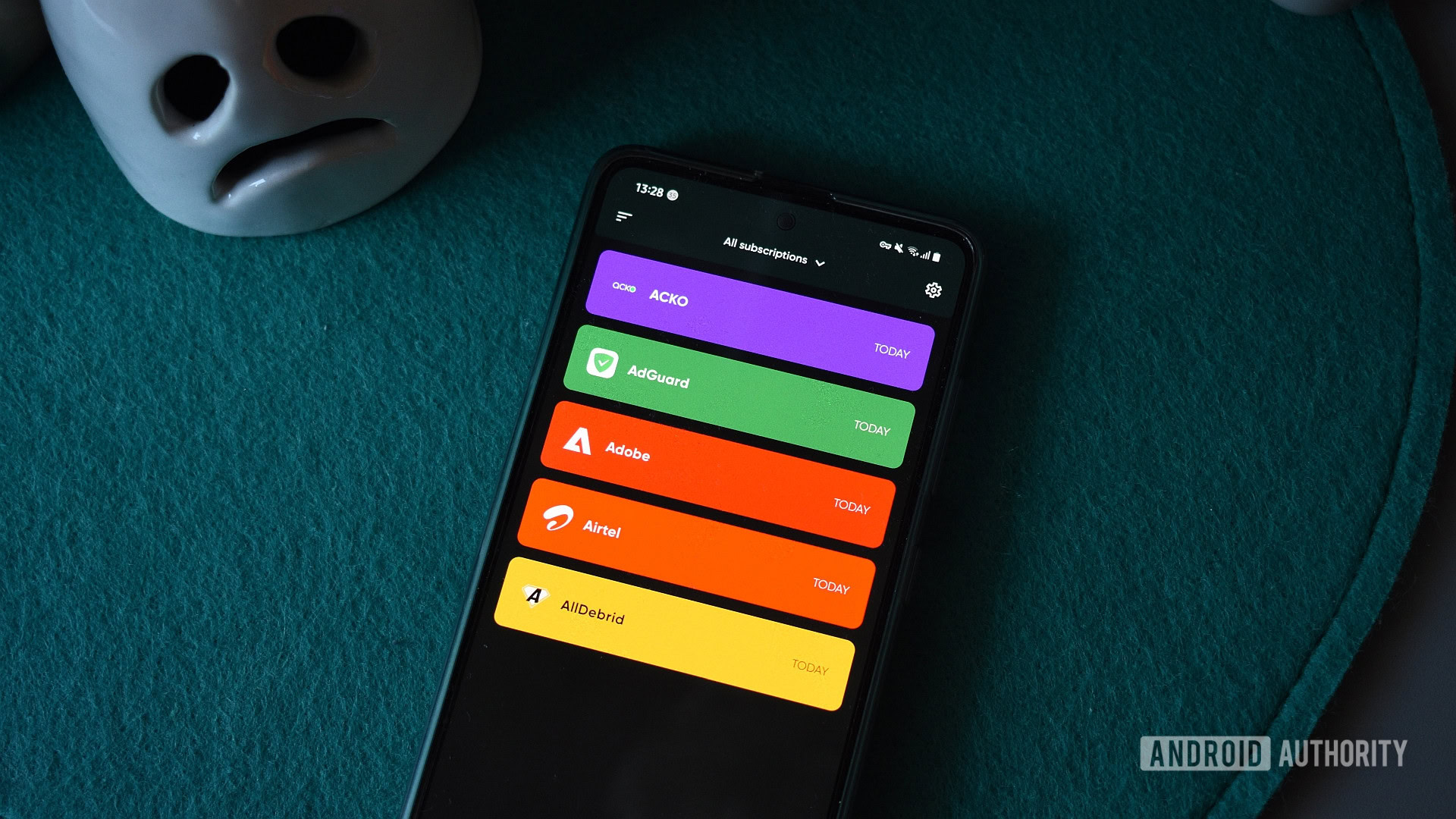Affiliate links on Android Authority may earn us a commission. Learn more.
This app helped me track my monthly subscriptions, but it's no silver bullet

We all have too many subscriptions throttling our bank balance. I know I do. Some are essential, while others are probably not integral to our daily lives. To separate these two categories, I sought the help of technology, specifically a subscription tracker app that would present this information in an easily digestible way.
This wasn’t my first solution, though. Initially, I tried using a note-taking app to jot down my subscriptions, but this was only a first step. I then tried Notion, but I spent more time creating the perfect layout than I did looking at the subscriptions. But, after much experimentation, I stumbled upon a fairly good solution: a subscription manager called SubX that bills itself as the “home of all your subscriptions” and allows users to list, monitor, budget for, and receive pending payment reminders.
For the most part, it’s the best Android app I’ve found on the Play Store for this purpose, but it’s not a silver bullet for my subscription monsters.
Do you use a subscription tracker app?
SubX is my favorite subscription tracker app on Android
SubX has plenty going for it, but its most significant strength is its broad array of subscriptions baked right into the app. I hate fishing out the minute details of my subscriptions, but this app simplifies this process.
Adding a subscription is as simple as tapping the large, yellow + icon and selecting the relevant service in your region. Regardless of the country you’re in, the app lists the various tiers and pricing for each, making this process a breeze.
SubX's strongest features are its price increase notifications and its long list of supported subscriptions.
You can indicate if a subscription was shared with another user when you first signed up (if you can remember) and if any taxes apply. The app also knows if any specific subscription tier features a trial period. For instance, Apple Music’s first month is free on the Student tier. The app was aware of this when I added it to my list and will defer the payment notification to the following month.
Another massive pro is how SubX handles price increases, a feature that’s dearly missing on other subscription tracker apps I’ve tried. You can find these details above the icon of each service you’re adding — the app will display “Good” or “Normal” to reflect how often the price increases in a given period. Tap on this little indicator to open a table that provides more details.
These price increases are also listed in a dedicated section within the app, but I wish this list could be filtered by region — I don’t need to know if Spotify increased in Australia or Denmark. I’m glad this feature exists nonetheless. The app also indicates the severity of the increase by displaying the previous and new pricing details and the percentage increase. More importantly, SubX will notify you if an increase is coming and when it takes effect. No more subscription shock.
After adding my plethora of subscriptions, I could deduce just how much impact they had on my bank balance. The app displays the total subscription expense at the top of the home page, alongside your income (if you choose to add this detail).
The Reports section places subscriptions on a nifty chart to show which one has the biggest grip on your wallet. It also totals the annual damage each subscription is responsible for. This is a real eye-opener, especially when you realize that something like ChatGPT Plus demands $240 a year or Adobe Creative Cloud almost $720.
As mentioned, though, SubX isn’t the be-all and end-all solution. I did encounter a few notable roadblocks that impacted my experience.
The app locks most features behind a one-time payment fee. Thanfully, it’s not a subscription or a steep investment, but I don’t appreciate the lack of a trial period. Trying every feature before buying an app is hugely important for me, and SubX doesn’t allow this.
Unfortunately, these Pro-tier limitations extend to the core part of the app: the number of subscriptions you can add. You can only add four subscriptions to your list. Want more? You’ll have to pay. Sure, it’s not the only subscription tracker app that does this, but it does offer fewer free entries than its rivals. This won’t be a blow for those with a few subscriptions, but it isn’t feasible for people like me.
You'll need to pay to add more than four subscriptions, but without a trial period, I can't justify spending more cash.
SubX isn’t the most elegant app I’ve ever used, either. Its UI is cluttered and laden with items that bloat rather than benefit. Thankfully, many of these elements can be hidden, but I don’t see the need for a Top News section, a Savings Score section, or a Smart Assistant box. These would be better integrated into other sections of the app. I hid all of these from the home screen.
Overall, SubX is a robust Android subscription tracker app with many clear positives, but the lack of a trial is a real deal breaker for me. Looks like I’ll have to try Notion again.
Are there any good subscription tracker apps out there?

There are plenty of other subscription tracker apps available for Android that are also worth considering. Here are a few that I’ve tried:
- Tilla: Its gorgeous UI makes Tilla far more approachable than SubX, but it lacks automatic tier and pricing details, price increase notifications, and a Reports-like overview page. It does offer dark mode and a widget right off the bat, but you will need to pay $2.49 if you want to add more than five subscriptions.
- Recurring Expense Tracker: This open source expense manager offers a clean UI, a biometric lock, and an expense breakdown page. It’s not as comprehensive as Tilla or SubX, though, but that will be a pro for some. More importantly, it’s free.
- Subscriptions: My original solution, Subscriptions has largely fallen from grace in recent years. Ironically, it now demands a subscription fee to remove ads, but it does offer plenty of subscription slots on the free tier.